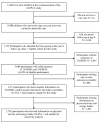Associations of 25-hydroxyvitamin D2 and D3 with cardiovascular risk factors in childhood: cross-sectional findings from the Avon Longitudinal Study of Parents and Children
- PMID: 22344194
- PMCID: PMC3927053
- DOI: 10.1210/jc.2011-2335
Associations of 25-hydroxyvitamin D2 and D3 with cardiovascular risk factors in childhood: cross-sectional findings from the Avon Longitudinal Study of Parents and Children
Abstract
Context: Studies in adults have reported associations of low circulating total 25-hydroxyvitamin D with increased cardiovascular disease and risk factors. Evidence of associations in children, however, is limited, and it is unknown whether associations with risk factors differ for each 25-hydroxyvitamin D analog [25-hydroxyvitamin D(2) (25[OH]D(2)) and 25-hydroxyvitamin D(2) (25[OH]D(3))].
Objective: The objective of the study was to compare associations of 25(OH)D(2) and 25(OH)D(3) with cardiovascular risk factors in children.
Design/setting: The design of the study was a cross-sectional study of 4274 children (mean age 9.9 yr) from the Avon Longitudinal Study of Parents and Children.
Main outcomes: The main outcomes included blood pressure, lipids [triglycerides, low-density lipoprotein cholesterol, high-density lipoprotein cholesterol (HDL-C)], apolipoproteins (Apo-A1 and Apo-B), adiponectin, leptin, C-reactive protein, and IL-6.
Results: In confounder-adjusted models, 25(OH)D(2) was inversely associated with Apo-A1 (change per doubling of exposure: -0.74 mg/dl; 95% confidence interval -0.14, -0.04) and triglycerides (relative percentage change per doubling of exposure: -1.64%; -3.27, 0.01) and positively associated with C-reactive protein (8.42%; 3.40, 13.58) and IL-6 (5.75%; 1.83, 9.25). 25(OH)D(3) was positively associated with HDL-C (0.04 mmol/liter; 0.02, 0.06), Apo-A1 (1.96 mg/dl; 0.65, 3.24), and adiponectin (0.47 μg/ml; 0.15, 0.79). There was statistical evidence that associations of 25(OH)D(2) and 25(OH)D(3) with HDL-C, Apo-A1, and IL-6 differed from each other (all P values for differences ≤0.02).
Conclusions: Higher circulating 25(OH)D(3) was associated with cardioprotective levels of HDL-C, Apo-A1, and adiponectin in children. Associations of 25(OH)D(2) with cardiovascular risk factors were in mixed directions. It is necessary to see whether these associations are replicated in large prospective studies.
Figures
References
-
- Kilkkinen A, Knekt P, Aro A, Rissanen H, Marniemi J, Heliövaara M, Impivaara O, Reunanen A. Vitamin D status and the risk of cardiovascular disease death. Am J Epidemiol. 2009;170:1032–1039. - PubMed
-
- Martins D, Wolf M, Pan D, Zadshir A, Tareen N, Thandhani R, Felsenfeld A, Levine B, Mehrotra R, Norris K. Prevalence of cardiovascular risk factors and the serum levels of 25-hydroxyvitamin D in the United States: data from the third National Health and Nutrition Examination Survey. Arch Intern Med. 2007;167:1159–1165. - PubMed
-
- Holick MF. Vitamin D deficiency. N Engl J Med. 2007;357:266–281. - PubMed
Publication types
MeSH terms
Substances
Grants and funding
LinkOut - more resources
Full Text Sources
Research Materials
Miscellaneous


